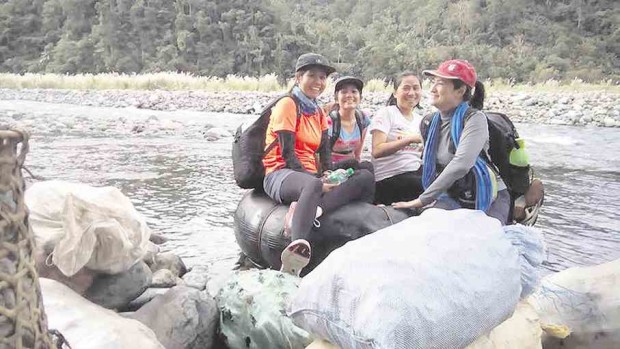
VOLUNTEERS board a “salbabida” as they prepare to cross the Binagao River in Bongabong town in Oriental Mindoro province for a medical-dental outreach program. CONTRIBUTED PHOTO
Sometime in February, Mangyan couple Mayagom and Mawaynan Wag-ay saved the life of their 1-year-old daughter, Desa, using a simple but effective device to cross a river from their mountain village in Bongabong town in Oriental Mindoro province.
Their child, Desa, was feverish and dehydrated following a bout with diarrhea, and they were bringing her to the hospital in the town center for treatment.
When the couple reached Binagao River, they floated on a salbabida (life buoy), the inner rubber tube of a truck wheel, from one bank to the other, then they rode on a motorcycle to the hospital.
Bangon subtribe
For a long time, the mountain villagers had relied on the balsa (raft made of banana trunks) to cross the river, which flows from Sitio Ginyang in Barangay Lisap to Barangay Orconuma, until they discovered that using the rubber tube was more practical.
The salbabida, which costs between P300 and P1,000 depending on size, has become part of the Mangyan way of life, said Gloria Lintawagin-Reyes and her husband, Arnold. The Mangyan couple are teachers of Hatubuan Elementary School in Bongabong, where children of the Bangon, the youngest of the seven Mangyan subtribes, study.
Reyes said the Wag-ays were forced to brave the river current on the salbabida after the community’s bamboo bridge collapsed. Mawaynan tightly held her sick child, who was kept dry with a wrap of plastic sheet, while Mayagom steered the tube.
“The salbabida is easier and faster to flow down the river, and has also become popular when trading goods,” said Reyes, a Mangyan Alangan and a researcher for the church-based Mangyan Mission.
Some 3,000 Bangon use the salbabida. They come from the sitio (subvillages) of Linyama and Lalid in Barangay Hagan; and Labay, Naswak, Iplaa and Ambuwan in Barangay Lisap. Hagan and Lisap are divided by Binagao River, named after a mythical maiden named “Bangon.”
Livelihood aid
Almost all men and boys are skilled in using the salbabida, Reyes’ husband said. “But more women are now using the salbabida to help in the family’s livelihood.”
He cited the case of Mawaynan Wag-ay, 37, the daughter of tribal leader Yawin-Ay in Sitio Naswak, Barangay Lisap, who has been assisting her husband in trading farm produce. She would transport 3,000 pieces of saba (banana variety) on the rubber float, followed by Mayagom, who would load 4,500 pieces on another.
The younger girls in the village, called hagina, have also learned to use the salbabida to earn a living.
Layda, Aynim and Limnay, all Grade 8 students living at Mangyan Mission’s San Mariano Formation Center in the nearby town of Roxas, transport kaingin (slash-and-burn agriculture) crops on the salbabida to sell on Saturdays, a day after going home to their mountain village.
They save what they earn as baon (school allowance) for the following week. They net between P30 and P40 per 100 small bananas, which are sold at P70. The bigger bananas are sold for at least P100.
If they hire a jeep or a motorcycle for transport instead of the salbabida, they will have to pay P10 per 100 bananas.
“The youngest of the salbabida users is among my Grade 3 pupils. Each salbabida could carry a sack of gabi (taro),” Arnold said.
Socialization
But girls would not be allowed to use the buoy if the river swells to more than 1.5 meters (5 feet) and when the current is strong.
Salbabida use has also become an avenue for socialization because some Bangon would interact with non-Mangyan visitors doing outreach programs as they help them cross the river.
The Reyes couple believe the Bangon would survive the harsh life in the mountain and adapt to conditions during natural calamities now that the salbabida has become a community tool.